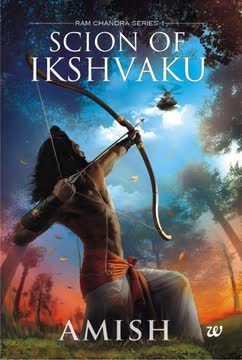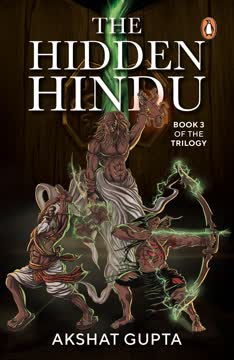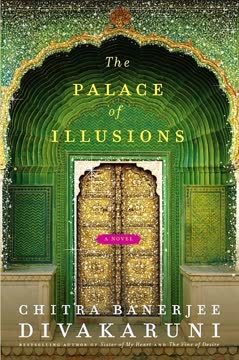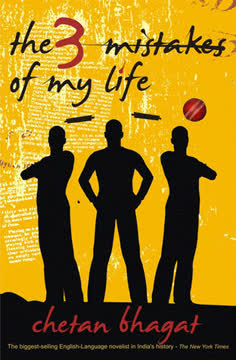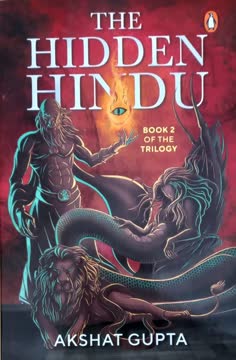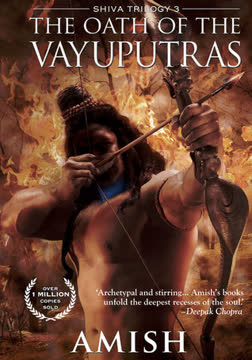Plot Summary
A Kingdom in Decline
The once-mighty kingdom of Ayodhya is in disarray under Emperor Dashrath, who is haunted by his defeat at the hands of Raavan, the demon-king of Lanka. This defeat has left the kingdom weakened and impoverished, with Dashrath a shadow of his former self. The nobility is divided, and Queen Kaikeyi holds significant sway over the emperor. Amidst this turmoil, the birth of Ram, Dashrath's eldest son, is seen as inauspicious, blamed for the kingdom's misfortunes. The people of Ayodhya, disillusioned and struggling, yearn for hope and leadership in a time of chaos and uncertainty.
The Birth of Ram
Born on the day of Dashrath's defeat, Ram is marked as a harbinger of bad luck. Despite this, his mother Kaushalya sees greatness in him, naming him after the sixth Vishnu, Lord Parshu Ram. Astrologers are conflicted about his future, as he is born exactly at midday, a time signifying both greatness and misfortune. Ram's birth sets the stage for a life of challenges, as he grows up under the shadow of his father's disappointment and the kingdom's decline. His journey is marked by a quest for identity and purpose, as he seeks to fulfill his destiny amidst the expectations and prejudices of those around him.
The Burden of Dharma
As Ram matures, he is sent to the gurukul of Vashishta, where he learns the principles of dharma, or duty. Despite the disdain he faces due to his birth, Ram remains steadfast in his commitment to truth and justice. His adherence to the law becomes a defining trait, earning him respect among the common people but disdain from the nobility. Ram's unwavering belief in dharma shapes his actions and decisions, setting him apart as a leader who values righteousness above all else. His journey is one of self-discovery, as he grapples with the complexities of duty, honor, and justice in a world that often challenges these ideals.
The Brothers' Bond
Ram shares a deep bond with his brothers, particularly Lakshman, who is fiercely loyal to him. Despite the political intrigue and familial tensions, the brothers remain united, supporting each other through trials and tribulations. Their relationship is a source of strength for Ram, providing him with the emotional support he needs to navigate the challenges of leadership and duty. The brothers' camaraderie is a testament to the power of family and loyalty, as they stand by each other in the face of adversity. Their bond is a central theme in Ram's journey, highlighting the importance of love and unity in overcoming obstacles.
The Law Giver's Dilemma
As the chief of police, Ram implements reforms that drastically reduce crime in Ayodhya. However, his strict adherence to the law is tested when Roshni, a beloved figure, is brutally murdered. The main perpetrator, Dhenuka, escapes the death penalty due to a legal technicality, leaving Ram torn between his duty to uphold the law and his desire for justice. This dilemma forces Ram to confront the limitations of the law and the complexities of justice, as he grapples with the consequences of his decisions. The incident serves as a turning point in Ram's journey, challenging his beliefs and shaping his understanding of leadership and morality.
A Call to Destiny
The arrival of Maharishi Vishwamitra, the chief of the Malayaputras, marks a significant moment in Ram's life. Vishwamitra seeks Ram's help to defend an ashram under attack, a request that confounds Dashrath and the queens. Despite the uncertainty, Ram is drawn to the opportunity, sensing a call to a greater purpose. Vishwamitra's presence signifies a turning point in Ram's journey, as he is thrust into a world of divine missions and ancient prophecies. This chapter sets the stage for Ram's transformation from a prince burdened by duty to a leader destined for greatness, as he embarks on a path that will define his legacy.
The Price of Justice
Bharat, driven by a sense of justice and loyalty to Roshni, takes matters into his own hands, orchestrating the brutal execution of Dhenuka. This act of vengeance, while satisfying the demand for justice, leaves a lasting impact on Bharat and Shatrughan, who are consumed by anger and guilt. The incident highlights the complexities of justice and the moral dilemmas faced by those in power. It serves as a cautionary tale about the dangers of letting anger and vengeance dictate actions, as the brothers grapple with the consequences of their choices. The chapter underscores the theme of justice and its price, as the characters navigate the fine line between right and wrong.
Vishwamitra's Unyielding Demand
Maharishi Vishwamitra arrives in Ayodhya, demanding Ram's assistance in defending an ashram. Despite familial tensions and political intrigue, Ram is compelled to accompany Vishwamitra, along with his brother Lakshman. The sage's insistence and the divided opinions within the royal family highlight the complex dynamics at play. Vashishta, the royal guru, is unable to prevent this course of action, indicating the powerful influence Vishwamitra wields. This chapter sets the stage for Ram's journey into a world of divine missions and ancient prophecies, marking a pivotal moment in his transformation from a prince burdened by duty to a leader destined for greatness.
The Asuraastra's Devastating Power
As tensions rise with Raavan's forces threatening Mithila, Vishwamitra proposes using the Asuraastra, a powerful weapon of mass incapacitation. Ram faces a moral crisis, torn between his duty to protect Mithila and the ethical implications of using such a weapon. Despite his reservations, Ram ultimately decides to fire the Asuraastra, leading to a devastating impact on Raavan's forces. This decision weighs heavily on Ram, as he grapples with the consequences of his actions and the burden of leadership. The chapter explores themes of duty, morality, and the price of justice, as Ram navigates the complexities of his role as a leader.
Exile and New Beginnings
Following the events in Mithila, Ram chooses to exile himself for fourteen years, adhering to the law he holds dear. Despite opposition from his family, Ram's commitment to justice and dharma prevails. Sita and Lakshman accompany him, embarking on a journey into the forests of Dandak. This chapter delves into the themes of sacrifice, duty, and the pursuit of righteousness, as Ram embraces his fate with unwavering resolve. The exile marks a new beginning for Ram, Sita, and Lakshman, as they navigate the challenges of life in the wilderness, forging a path towards their destiny.
The Lure of Shurpanakha
In the forests of Panchavati, Ram, Sita, and Lakshman encounter Shurpanakha, Raavan's sister, who is captivated by Ram. Her advances and subsequent rejection lead to a violent confrontation, resulting in her disfigurement. This incident sets off a chain of events that escalate tensions with Lanka, as Shurpanakha's humiliation demands retribution. The chapter explores themes of desire, pride, and the consequences of unchecked emotions, as the characters grapple with the fallout of their actions. Shurpanakha's presence serves as a catalyst for the unfolding drama, propelling the narrative towards a climactic confrontation.
The Abduction of Sita
The tranquility of Panchavati is shattered when Raavan abducts Sita, leaving Ram and Lakshman devastated. The brothers' desperate pursuit is thwarted by the formidable Pushpak Vimaan, Raavan's flying vehicle. This chapter highlights the themes of love, loss, and the relentless pursuit of justice, as Ram vows to rescue Sita and restore her honor. The abduction serves as a turning point in the narrative, propelling Ram on a quest that will test his resolve and redefine his destiny. The chapter sets the stage for an epic confrontation between good and evil, as Ram embarks on a journey to reclaim what has been taken from him.
The Pursuit of Destiny
In the aftermath of Sita's abduction, Ram is consumed by a singular purpose: to rescue his beloved and confront Raavan. Joined by allies old and new, Ram's journey is fraught with challenges and revelations. As he navigates the complexities of his mission, Ram's character is tested, and his understanding of dharma deepens. This chapter explores themes of destiny, courage, and the transformative power of love, as Ram embraces his role as a leader and a warrior. The pursuit of Sita becomes a metaphor for Ram's quest for self-discovery and fulfillment, as he strives to uphold the values he holds dear.
Characters
Ram
Ram, the eldest son of Dashrath, is marked by his unwavering commitment to dharma, or duty. Despite being blamed for Ayodhya's misfortunes, he remains steadfast in his pursuit of justice and truth. His adherence to the law earns him respect among the common people but alienates him from the nobility. Ram's journey is one of self-discovery, as he grapples with the complexities of leadership and morality. His character is defined by his integrity, compassion, and dedication to serving his people, making him a symbol of hope and righteousness in a world fraught with challenges.
Lakshman
Lakshman, Ram's younger brother, is known for his unwavering loyalty and fierce protectiveness towards Ram. He shares a deep bond with his elder brother, often putting himself in harm's way to ensure Ram's safety. Lakshman's impulsive nature and strong sense of justice drive him to act decisively, often without regard for the consequences. His character is marked by his bravery, devotion, and willingness to stand by his brother through thick and thin, making him an indispensable ally in Ram's journey.
Bharat
Bharat, another of Ram's brothers, is characterized by his strong sense of justice and loyalty to his family. He is deeply affected by Roshni's death and takes it upon himself to seek justice, even if it means breaking the law. Bharat's actions highlight the moral dilemmas faced by those in power, as he grapples with the consequences of his choices. His character is defined by his passion, determination, and willingness to fight for what he believes is right, even at great personal cost.
Dashrath
Dashrath, the emperor of Ayodhya, is a once-great warrior now broken by defeat and guilt. His inability to overcome his past failures has left him a shadow of his former self, struggling to maintain control over his kingdom. Dashrath's relationship with Ram is complex, marked by regret and a desire for redemption. His character serves as a cautionary tale about the dangers of pride and the importance of accepting responsibility for one's actions.
Kaikeyi
Kaikeyi, Dashrath's second wife, is a powerful and ambitious figure in the Ayodhyan court. Her influence over Dashrath and her desire to see her son Bharat succeed drive her actions, often leading to conflict with Ram. Kaikeyi's character is marked by her cunning, determination, and willingness to do whatever it takes to achieve her goals, making her a formidable force in the political landscape of Ayodhya.
Vashishta
Vashishta, the raj guru of Ayodhya, is a wise and enigmatic figure who plays a crucial role in shaping Ram's understanding of dharma and leadership. His teachings and guidance help Ram navigate the complexities of duty and justice, providing him with the wisdom needed to fulfill his destiny. Vashishta's character is defined by his knowledge, insight, and deep understanding of the human condition, making him a mentor and father figure to Ram.
Vishwamitra
Vishwamitra, the chief of the Malayaputras, is a complex figure whose actions drive much of the narrative. His insistence on Ram's participation in defending the ashram reveals his influence and authority. Vishwamitra's willingness to use the Asuraastra highlights his pragmatic approach to achieving his goals, often at odds with Ram's moral compass. His character embodies the tension between duty and ethics, as he navigates the intricate dynamics of power and prophecy.
Shurpanakha
Shurpanakha, Raavan's sister, is a pivotal character whose actions set off a chain of events leading to conflict. Her attraction to Ram and subsequent rejection result in a violent confrontation, escalating tensions with Lanka. Shurpanakha's character explores themes of desire, pride, and the consequences of unchecked emotions, serving as a catalyst for the unfolding drama.
Jatayu
Jatayu, a Malayaputra and ally to Ram, plays a crucial role in the narrative. His dedication to protecting Sita and Ram is unwavering, ultimately leading to his demise during Raavan's attack. Jatayu's character embodies themes of loyalty, sacrifice, and the tragic cost of duty, highlighting the complexities of allegiance and the price of devotion.
Vibhishan
Vibhishan, Raavan's younger brother, is a character torn between familial loyalty and moral integrity. His plea for refuge with Ram reflects his disillusionment with Raavan's tyranny. Vibhishan's character explores themes of betrayal, redemption, and the struggle for identity, as he navigates the delicate balance between allegiance and righteousness.
Hanuman
Hanuman, a powerful Naga, is introduced as a key ally in Ram's quest. His mission to protect Ram and Sita underscores his significance in the unfolding events. Hanuman's character embodies themes of strength, loyalty, and divine purpose, as he plays a crucial role in the narrative's progression towards an epic confrontation.
Plot Devices
Dharma and Law
The concepts of dharma (duty) and law are central to the narrative, shaping the characters' actions and decisions. Ram's adherence to dharma and the law is a defining trait, guiding his journey and influencing the events of the story. The tension between justice and the law is explored through the characters' struggles, highlighting the complexities of leadership and morality. This plot device serves as a lens through which the characters' motivations and conflicts are examined, providing depth and nuance to the overarching narrative.
Brotherhood and Loyalty
The strong bond between Ram and his brothers is a key plot device, providing emotional depth and driving the narrative forward. Their loyalty and support for each other are tested through various trials, highlighting the themes of family and unity. This device underscores the importance of relationships and the role they play in shaping the characters' journeys, adding layers of complexity to the story.
Prophecy and Destiny
The themes of prophecy and destiny are woven throughout the narrative, influencing the characters' paths and decisions. Vishwamitra's arrival and the divine missions he represents serve as catalysts for Ram's transformation, drawing him into a larger cosmic plan. This plot device adds an element of mysticism and intrigue to the story, as the characters navigate the interplay between free will and fate, shaping their destinies in a world governed by divine forces.
Asuraastra
The Asuraastra, a powerful weapon of mass incapacitation, serves as a central plot device in the narrative. Its use by Ram highlights the moral dilemmas faced by leaders in times of crisis. The Asuraastra's devastating impact on Raavan's forces underscores the themes of duty, justice, and the ethical complexities of wielding power. This plot device propels the narrative forward, challenging characters to confront the consequences of their actions and the price of leadership.
Exile
Ram's self-imposed exile serves as a significant plot device, marking a period of transformation and growth. The exile explores themes of sacrifice, duty, and the pursuit of righteousness, as Ram, Sita, and Lakshman navigate the challenges of life in the wilderness. This journey of self-discovery shapes the characters' understanding of dharma and destiny, setting the stage for their eventual return and the fulfillment of their roles in the larger cosmic plan.
Analysis
"Scion of Ikshvaku" by Amish Tripathi is a profound exploration of the themes of duty, justice, and destiny, set against the backdrop of a mythological narrative. The book delves into the complexities of leadership and morality, as Ram navigates the challenges of upholding dharma in a world fraught with chaos and uncertainty. Through the characters' struggles and triumphs, the narrative examines the tension between personal desires and the greater good, highlighting the sacrifices required to fulfill one's destiny. The story serves as a timeless reflection on the human condition, offering insights into the nature of power, responsibility, and the pursuit of righteousness. As Ram's journey unfolds, readers are invited to contemplate the intricate interplay between free will and fate, and the transformative power of love and loyalty in overcoming adversity.
Last updated:
FAQ
Synopsis & Basic Details
What is Scion of Ikshvaku about?
- A Kingdom's Decline: Scion of Ikshvaku introduces Ayodhya, a once-glorious empire now weakened and impoverished under Emperor Dashrath, haunted by a devastating defeat to the demon-king Raavan. This sets the stage for a society grappling with lost prestige and internal strife.
- Ram's Burdened Birth: The narrative centers on Ram, Dashrath's eldest son, whose birth is tragically linked to his father's defeat, leading to him being branded inauspicious and largely neglected by the royal court. His journey explores themes of duty, law, and the struggle for acceptance.
- Quest for Dharma and Justice: The story follows Ram's upbringing in a gurukul, his unwavering commitment to dharma and law, and his efforts to restore order as Ayodhya's police chief, culminating in a moral dilemma involving a brutal crime and a controversial legal technicality. This leads to a pivotal confrontation with Raavan and a self-imposed exile.
Why should I read Scion of Ikshvaku?
- Mythology Reimagined: Amish Tripathi offers a fresh, grounded reinterpretation of the ancient Ramayana, presenting its characters and events with human complexities, political intrigue, and philosophical depth, making it accessible and thought-provoking for a modern audience.
- Deep Philosophical Debates: The novel delves into profound discussions on governance, justice, and societal structures, contrasting rigid adherence to law with the pursuit of freedom, and exploring the cyclical nature of civilizations (masculine vs. feminine ways of life).
- Character-Driven Conflict: Readers will be drawn into the psychological struggles and evolving relationships of characters like Ram, Sita, Lakshman, and Bharat, whose personal journeys are intertwined with the fate of their kingdom, offering rich emotional resonance and unexpected turns.
What is the background of Scion of Ikshvaku?
- Ancient Indian Setting: The story is set in 3400 BCE India, specifically the Sapt Sindhu region, a land of ancient kingdoms like Kosala (Ayodhya) and Mithila, and introduces diverse tribes such as the Malayaputras, Vayuputras, and Nagas, each with unique philosophies and roles.
- Post-War Economic Decline: Ayodhya's political and economic landscape is shaped by its humiliating defeat to Lanka, leading to reduced trade commissions and widespread poverty, which fuels internal dissent and a yearning for a strong leader.
- Philosophical and Social Context: The narrative is steeped in Vedic philosophy, exploring concepts like dharma, karma, and the Ekam (One God), while also addressing societal issues like the rigid caste system and the role of women in leadership, reflecting a blend of ancient wisdom and contemporary relevance.
What are the most memorable quotes in Scion of Ikshvaku?
- "People will talk nonsense. It is, after all, their job.": This quote, attributed to Guru Vashishta, encapsulates Ram's stoic resilience against public opinion and calumny, highlighting his inner strength and focus on duty over external validation.
- "Dharma is above all, even the king. Dharma is above the Gods themselves.": A powerful statement, initially spoken by Dashrath at his coronation and later recalled by Ram, it underscores the supreme importance of righteousness and law in the ideal governance of a kingdom, a core theme in Scion of Ikshvaku.
- "I have become alive. You have made me alive.": Ram's internal declaration upon successfully stringing the Pinaka bow and hitting the target, this quote symbolizes his profound emotional awakening and the transformative impact of Sita on his life, marking a pivotal moment in their relationship.
What writing style, narrative choices, and literary techniques does Amish Tripathi use?
- Accessible Mythological Retelling: Amish Tripathi employs a straightforward, engaging narrative style that makes complex mythological concepts and ancient history accessible to a broad audience, blending epic storytelling with modern sensibilities.
- Philosophical Dialogue & Internal Monologue: The author frequently uses extensive dialogues between characters, particularly Ram and his gurus or brothers, to explore philosophical debates on dharma, governance, and human nature, often complemented by characters' internal reflections on their moral dilemmas.
- Foreshadowing and Symbolism: Tripathi subtly weaves in elements of foreshadowing, such as Lakshman's constant suspicions or Vashishta's cryptic warnings, and uses recurring symbols like the Pinaka bow, the Grand Canal, and the Somras to deepen thematic resonance and hint at future events.
Hidden Details & Subtle Connections
What are some minor details that add significant meaning?
- Nilanjana's Astrological Manipulation: The royal physician Nilanjana's decision to record Ram's birth "a minute before midday" (Chapter 3) subtly highlights the human desire to influence destiny and protect loved ones, even through minor deceptions, foreshadowing the constant struggle between fate and free will in Ram's life.
- Kaikeyi's Finger Injury: The detail of Kaikeyi losing a finger while saving Dashrath (Chapter 3) is not just a physical scar but a symbolic representation of her deep personal sacrifice and the immense, unacknowledged debt Dashrath owes her, which she later leverages with the "two boons."
- The Grand Canal's Decay: Vashishta's observation of the Grand Canal's silting, peeling paint, and chipped sandstone (Chapter 4) serves as a powerful visual metaphor for Ayodhya's broader decline, reflecting not just financial woes but a loss of civic pride and administrative will, a subtle detail of the kingdom's decay.
What are some subtle foreshadowing and callbacks?
- Vashishta's Blood Oath: Guru Vashishta's secret blood oath by the Grand Canal, swearing to "make my rebellion succeed" (Chapter 4), subtly foreshadows his long-term, manipulative plan to reshape India's future through Ram, indicating a deeper, more complex agenda than mere mentorship.
- Lakshman's Eavesdropping: Lakshman's repeated, unheeded eavesdropping on Vashishta's clandestine meetings (Chapters 7, 9) consistently foreshadows impending danger or hidden agendas, highlighting his fierce protectiveness and Ram's trusting, sometimes naive, nature.
- Sita's "Thread in a Necklace": Lakshman's internal thought about Sita having "that something, like the thread in a crystal-bead necklace. She holds it all together" (Chapter 23) subtly foreshadows Sita's crucial role as Ram's emotional anchor and strategic partner, hinting at her indispensable influence on his destiny.
What are some unexpected character connections?
- Manthara's Personal Vengeance: Manthara's intense drive for Dhenuka's brutal punishment (Chapter 13) is revealed to be deeply personal, stemming from Roshni's death, transforming her from a mere political schemer into a figure consumed by grief and a desire for retribution, adding a layer of emotional complexity to her actions.
- Vishwamitra's Past with Vashishta: The revelation of Vishwamitra and Vashishta's shared past and Vishwamitra's use of Vashishta's childhood name, "Divodas" (Chapter 15), hints at a deeper, unresolved conflict and a complex history between the two powerful sages, suggesting a rivalry beyond mere philosophical differences.
- Hanuman's Early Appearance: The brief, almost anonymous introduction of Hanuman as the "hirsute Naga leader of the Parihans" (Chapter 30) who is "vital" to both Ram and Sita, subtly foreshadows his immense importance and loyalty in their future quest, establishing his character before his full mythological role is revealed.
Who are the most significant supporting characters?
- Nilanjana, the Royal Physician: Beyond her medical duties, Nilanjana's quiet loyalty to Kaushalya and her subtle manipulation of Ram's birth record (Chapter 3) highlight the hidden power dynamics and personal allegiances within the royal household, influencing Ram's early life.
- Manthara, the Wealthy Merchant: More than just Kaikeyi's confidante, Manthara's immense wealth and her personal vendetta for Roshni's murder (Chapter 13) make her a formidable, independent force, capable of swaying royal decisions and influencing the political landscape of Ayodhya.
- Jatayu, the Naga Captain: Jatayu's unwavering loyalty to Sita and Ram, despite his Malayaputra allegiance to Vishwamitra, and his tragic sacrifice (Chapter 30) underscore the theme of personal dharma overriding tribal or political affiliations, making him a poignant symbol of devotion.
Psychological, Emotional, & Relational Analysis
What are some unspoken motivations of the characters?
- Dashrath's Guilt and Redemption: Dashrath's initial disdain for Ram is an unspoken projection of his own guilt and shame over his defeat by Raavan, which he externalizes onto his "inauspicious" son. His later reconciliation and decision to name Ram "protector" (Chapter 12) is driven by a desperate, unspoken desire for personal redemption and to secure his legacy through Ram's greatness.
- Kaikeyi's Vicarious Ambition: Kaikeyi's relentless push for Bharat's ascension is not solely for his benefit but an unspoken attempt to achieve her own thwarted ambitions and prove her worth through her son, a reflection of her frustration with a society that "did not value capable women" (Chapter 6).
- Ram's Need for Validation: Despite his stoicism, Ram's unwavering adherence to law and his self-imposed exile are partly driven by an unspoken need to prove his worthiness and cleanse the "taint of 7,032" (Chapter 5), seeking validation not from others, but from his own rigorous moral code.
What psychological complexities do the characters exhibit?
- Ram's Stoic Idealism vs. Inner Turmoil: Ram consistently presents a calm, law-abiding exterior, but his self-inflicted burn for Dhenuka's escape (Chapter 13) and his silent fury at Vishwamitra's manipulation (Chapter 20) reveal a deep psychological complexity: an idealistic soul grappling with immense inner pain and the burden of upholding an absolute moral code in an imperfect world.
- Bharat's Pragmatic Rebellion: Bharat, while deeply loyal to Ram, exhibits a complex psychological duality: he champions freedom and pragmatism, even breaking the law for "justice" (Dhenuka's murder, Chapter 14), yet he refuses to usurp Ram's throne, showing a nuanced understanding of loyalty and a personal moral compass that prioritizes brotherhood over ambition.
- Vishwamitra's Ruthless Pragmatism: Vishwamitra's character is a study in ruthless pragmatism, willing to manipulate, lie, and use devastating weapons like the Asuraastra (Chapter 24) for what he perceives as the "greater good." His psychological complexity lies in his conviction that the ends justify the means, even if it means sacrificing individual morality for collective benefit.
What are the major emotional turning points?
- Dashrath's Hunting Trip Revelation: The leopard attack during the hunting trip (Chapter 11) serves as a major emotional turning point for Dashrath, forcing him to confront his own cowardice and Ram's unwavering dharma, leading to a profound shift in his perception of his eldest son and a genuine emotional reconciliation.
- Roshni's Murder and its Aftermath: Roshni's brutal murder (Chapter 13) is a devastating emotional turning point, triggering intense grief and a thirst for vengeance in Bharat and Manthara, while forcing Ram into a profound moral crisis that leads to his self-punishment and ultimately, his decision for exile.
- Ram's Encounter with Sita at the Market: Ram's first true encounter with Sita at the market (Chapter 23), where he witnesses her strength, adherence to law, and fierce protection of the weak, is a pivotal emotional turning point, causing him to "bow his head in admiration" and marking the beginning of his deep love and respect for her.
How do relationship dynamics evolve?
- Dashrath and Ram's Reconciliation: Their relationship transforms from one of neglect and blame (Ram's "inauspicious" birth) to a profound, albeit brief, reconciliation after the hunting trip (Chapter 11), where Dashrath finally acknowledges Ram's virtue and names him "protector," a significant evolution from their strained past.
- Ram and Sita's Partnership: Their relationship evolves from a formal, arranged alliance into a deep, complementary partnership built on mutual respect, shared ideals, and unwavering support, as evidenced by Sita's understanding of Ram's moral struggles and her decision to join him in exile (Chapter 26).
- Lakshman's Unwavering Devotion: Lakshman's relationship with Ram is characterized by an almost obsessive loyalty and protectiveness, evolving from childhood mischief to a mature, self-sacrificing devotion where he consistently prioritizes Ram's safety and well-being, even at the cost of his own happiness (joining exile, Chapter 28).
Interpretation & Debate
Which parts of the story remain ambiguous or open-ended?
- Vashishta's Ultimate Goal: While Vashishta states his goal is to "rejuvenate" India and make Ram the next Vishnu (Chapter 4, 27), the full extent of his long-term plan and the specific "ground" he prepares for Ram during exile remain ambiguous, leaving readers to ponder the precise nature of his grand design.
- The Vayuputras' True Intentions: The Vayuputras, particularly Hanuman, are introduced as allies, but their deep-seated adherence to Lord Rudra's laws and their mysterious, hidden nature (Chapter 30) leave their full role and potential future conflicts with Ram's evolving dharma open to interpretation.
- The Nature of Raavan's Power: While Raavan is portrayed as a formidable antagonist, the source of his immense wealth, advanced technology (Pushpak Vimaan), and the true extent of his influence beyond Lanka remain somewhat ambiguous, hinting at a larger, unexplored network of power.
What are some debatable, controversial scenes or moments in Scion of Ikshvaku?
- Dhenuka's Extrajudicial Killing: Bharat's orchestration of Dhenuka's brutal murder (Chapter 14), despite Ram's strict adherence to the law, is highly debatable. It raises questions about whether "justice" can exist outside the legal framework and if personal vengeance, however righteous, can ever be justified, challenging Ram's core philosophy.
- The Use of the Asuraastra: Ram's decision to fire the Asuraastra (Chapter 24), a biological weapon, despite Sita's and Lord Rudra's law against daivi astras, is controversial. It forces a debate on the ethics of warfare, the "lesser of two evils," and whether a leader should compromise their principles to save their people, even if it means breaking a sacred law.
- Kaikeyi's Two Boons: Kaikeyi's manipulative use of Dashrath's "two boons" to banish Ram and crown Bharat (Chapter 27) is a controversial act. It sparks debate on the nature of promises, the morality of leveraging past sacrifices for personal gain, and whether her actions, though seemingly cruel, ultimately serve a larger, perhaps unintended, purpose in Ram's destiny.
Scion of Ikshvaku Ending Explained: How It Ends & What It Means
- Sita's Abduction and Ram's Devastation: The book concludes with Raavan's audacious abduction of Sita via the Pushpak Vimaan, leaving Ram and Lakshman devastated and Jatayu mortally wounded. This climactic event shatters the relative peace of their exile and propels Ram into his ultimate quest.
- The Call to Destiny and Regeneration: Jatayu's dying words, "Lady Sita... must be saved... Vishnu... Lady Sita..." (Chapter 30), explicitly link Sita's rescue to Ram's destiny as the next Vishnu. This signifies that the abduction is not merely a personal tragedy but a catalyst for Ram to fully embrace his divine purpose and lead India's regeneration from the south.
- A New Beginning for the Epic Journey: The ending of Scion of Ikshvaku is a clear setup for the subsequent books in the Ram Chandra series. It marks the end of Ram's period of self-discovery and penance in exile, and the beginning of his active pursuit of his destiny, transforming him from a law-giver into a warrior-savior, ready to confront the ultimate evil.
Review Summary
Scion of Ikshvaku receives mixed reviews. Some praise its fresh take on Ramayana, philosophical depth, and engaging storytelling. Others criticize character development, modern language use, and deviations from the original epic. Amish's writing style and world-building draw comparisons to his previous Shiva Trilogy. While some readers appreciate the reimagined characters and societal themes, others find the alterations jarring. The book's pacing and action scenes receive positive mentions, but some feel it lacks the impact of Amish's earlier works. Overall, opinions are divided on this retelling of Ram's story.
Ram Chandra Series
Similar Books
Download PDF
Download EPUB
.epub digital book format is ideal for reading ebooks on phones, tablets, and e-readers.
